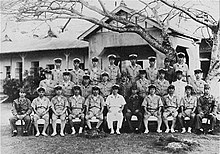Nagumo Chūichi
Nagumo Chūichi ( Japanese 南 雲 忠 一 ; born March 25, 1887 in Yamagata , † July 6, 1944 in Saipan , Northern Mariana Islands ) was a Vice Admiral in the Imperial Japanese Navy . He was in command of the successful attack on Pearl Harbor and the air strike on Darwin , but was defeated in the Battle of Midway .
Life
After graduating from the Naval Academy in 1908, he served on various ships in the Japanese Navy. In 1917 he became an officer on the destroyer Kisaragi . He was promoted to commander ( frigate captain ) in 1924 . From March 20, 1926 to October 15, 1926 he was the captain of the gunboat Saga . This was followed by command of the gunboat Uji from October 15, 1926 to November 15, 1927. From 1927 to 1929 he was a lecturer at the Naval Academy. Nagumo was promoted to sea captain in November 1929 and took command of the light cruiser Naka . From 1930 to 1931 he was in command of the 11th Destroyer Division. From 1931 to 1933 he held administrative positions in the Navy. From 1933 to 1934 he took command of the heavy cruiser Takao . This was followed by command of the battleship Yamashiro from 1934 to 1935 . On November 1, 1935, he was promoted to Rear Admiral. He was now in command of the 8th Cruiser Division. From 1937 to 1938 he was in command of the torpedo school. From 1938 to 1939 he was in command of the 3rd cruiser division. Nagumo was promoted to Vice Admiral on November 15, 1939 . From November 1940 to April 1941 Nagumo was the commandant of the Naval Academy.
After dealing with aircraft carrier attack tactics , on April 10, 1941, he was given supreme command of the 1st Japanese Navy Air Force, although he had no experience with the Navy Air Force. With these units he carried out the attack on Pearl Harbor under the command of Admiral Yamamoto Isoroku . Yamamoto originally wanted to command the carrier fleet himself, which the Japanese naval command prevented. Yamamoto and Nagumo were congratulated on the success of the attack. However, Yamamoto was dissatisfied with Nagumo's execution of the plan, since in his eyes he had not completely fulfilled the mandate. The US aircraft carriers that were not in port due to an exercise had not been sunk, nor had all ships been sunk in the port itself. The fuel depots and other supply depots were also not destroyed. Nagumo had also failed to carry out the attack on Midway docks , which had been included in Yamamoto's plans for the return journey from Pearl Harbor, due to bad weather. After the first two waves of attack, the commanders of the carrier aircraft had demanded that the aircraft be refueled and re-armed in order to destroy all possible targets. Nevertheless, he decided against the advice of the experts.
He then fought several other battles during the Pacific War with his aircraft carrier group Kidō Butai , including attacks on Rabaul , Darwin and Ceylon . There his troops succeeded, among other things, in the sinking of the British aircraft carrier HMS Hermes ( attack in the Indian Ocean ) on April 9, 1942 .
In one of the decisive battles of World War II , the Battle of Midway , Admiral Nagumo Chūichi lost all four naval carriers. As a result, he came under criticism from his superiors and the Japanese people. He was accused of not having gone into battle with full commitment. After this battle, the Japanese carrier forces were reorganized, Nagumo now received command of the 3rd fleet, which was formed around the two remaining fleet carriers Shōkaku and Zuikaku . With this he took part in the sea battles of the East Solomon Islands and the Santa Cruz Islands in the course of the Battle of Guadalcanal . In November 1942 he was finally replaced by Vice Admiral Ozawa Jisaburō and recalled to Japan, where he successively commanded the naval districts Sasebo and Kure and the 1st Fleet held in reserve.
In early 1944 Nagumo was given command of the newly formed Central Pacific Area Fleet to defend the Mariana Islands , but after the Americans retook Saipan in the Northern Mariana Islands , he decided to end his life according to the rules of Bushido and shoot himself before he had to surrender with his troops. A unit of US Marines found his body in his underground command center. He was posthumously awarded the rank of admiral by the Japanese emperor and awarded the second highest Japanese military order, the Order of the Golden Dragon .
DVD
- Encyclopaedia Of World War 2 . Volume 8. Chuichi Nagumo To Arthur Percival, 2002, PAL
Web links
- WW2DB: Chuichi Nagumo (English)
Individual evidence
- ↑ See Edwin P. Hoyt: Yamamoto. The man who planned Pearl Harbor . McGraw-Hill, New York et al. a. 1990, pp. 135-139
| personal data | |
|---|---|
| SURNAME | Nagumo, Chūichi |
| ALTERNATIVE NAMES | 南 雲 忠 一 (Japanese) |
| BRIEF DESCRIPTION | Vice Admiral in the Imperial Japanese Navy |
| DATE OF BIRTH | March 25, 1887 |
| PLACE OF BIRTH | Yamagata |
| DATE OF DEATH | July 6, 1944 |
| Place of death | Saipan |

